九年级英语Unit5复习学案教案
人教九年级英语unit5教案
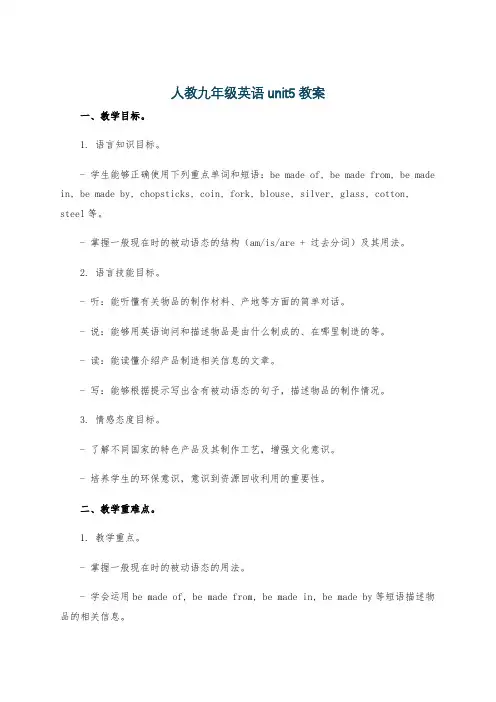
人教九年级英语unit5教案一、教学目标。
1. 语言知识目标。
- 学生能够正确使用下列重点单词和短语:be made of, be made from, be made in, be made by, chopsticks, coin, fork, blouse, silver, glass, cotton,steel等。
- 掌握一般现在时的被动语态的结构(am/is/are + 过去分词)及其用法。
2. 语言技能目标。
- 听:能听懂有关物品的制作材料、产地等方面的简单对话。
- 说:能够用英语询问和描述物品是由什么制成的、在哪里制造的等。
- 读:能读懂介绍产品制造相关信息的文章。
- 写:能够根据提示写出含有被动语态的句子,描述物品的制作情况。
3. 情感态度目标。
- 了解不同国家的特色产品及其制作工艺,增强文化意识。
- 培养学生的环保意识,意识到资源回收利用的重要性。
二、教学重难点。
1. 教学重点。
- 掌握一般现在时的被动语态的用法。
- 学会运用be made of, be made from, be made in, be made by等短语描述物品的相关信息。
2. 教学难点。
- 区分be made of和be made from的用法差异。
- 正确运用一般现在时的被动语态进行书面表达。
三、教学方法。
1. 情景教学法。
通过创设各种与物品制作相关的情景,让学生在真实的语境中学习和运用英语。
2. 任务驱动法。
布置各种任务,如小组讨论、角色扮演、调查等,让学生在完成任务的过程中提高语言综合运用能力。
3. 直观教学法。
运用图片、实物等直观教具,帮助学生更好地理解和记忆单词和短语。
四、教学过程。
(一)导入(5分钟)1. 展示一些常见物品的图片,如筷子、硬币、衬衫等,问学生:“What can you see in the pictures?”引导学生说出这些物品的英文名称。
2. 然后拿出一个用竹子做的筷子和一个用金属做的硬币,问学生:“What are they made of?”引出本节课的重点短语be made of。
仁爱版九年级英语下册Unit 5单元复习导学案
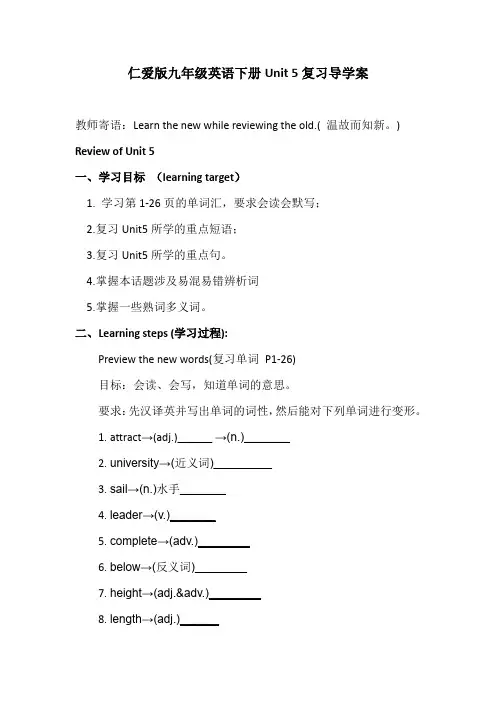
仁爱版九年级英语下册Unit 5复习导学案教师寄语:Learn the new while reviewing the old.( 温故而知新。
) Review of Unit 5一、学习目标(learning target)1. 学习第1-26页的单词汇,要求会读会默写;2.复习Unit5所学的重点短语;3.复习Unit5所学的重点句。
4.掌握本话题涉及易混易错辨析词5.掌握一些熟词多义词。
二、Learning steps (学习过程):Preview the new words(复习单词P1-26)目标:会读、会写,知道单词的意思。
要求:先汉译英并写出单词的词性,然后能对下列单词进行变形。
1.attract→(adj.)______ →(n.)_______2.university→(近义词)_________3.sail→(n.)水手_______4.leader→(v.)_______plete→(adv.)________6.below→(反义词)________7.height→(adj.&adv.)________8.length→(adj.)______9.eastern→(n.)_______10.enemy→(pl.)______三、下列单词是熟词多义,要求同学们掌握并灵活运用.1. state (n.) 国家;州;政府;状态;状况(v.)陈述;说明如:Couldn't he wait some minutes so that I can ask about my son's state? (状况)The facts are clearly stated in the report.(陈述)2. remain (v.) 剩余,遗留;仍然是;保持不变;继续存在;如: Tom was surprised at his act, but he remained silent.(保持不变)3. treasure (n.) 财富;珍宝;珠宝;宝物;金银财宝(v.)珍惜;珍爱;珍藏如:Treasure what you have.(珍惜)We should treasure the things and the people around us .(珍爱)4. trade (n.)贸易,买卖,交易;手艺(v.)互相交换,以物易物;如:the building/tourist trade 建筑业/旅游业Trade was very good last month.(交易量)When he leaves school,he wants to learn a trade. (手艺)Early explorers traded directly with the Indians.(交易)5. express (v.)表达;表露;表示;快递,邮寄(adj.)特快的;快速的;快递的如:As soon as I receive payment,I will express the book toyou.(快递)The letter was sent to us by express mail.(快递的)四、短语积累:要求同学们能对下列短语进行英汉互译。
Unit5 阅读复习课导学案- 人教版九年级全册英语
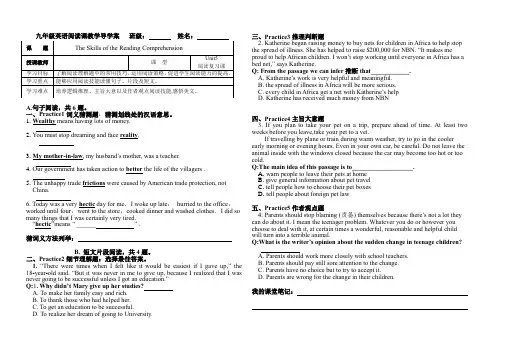
D.tell people about foreign pet law
五、Practice5作者观点题
4.Parents should stop blaming (责备) themselves because there’s not a lot they can do about it. I mean the teenager problem. Whatever you do or however you choose to deal with it, at certain times a wonderful, reasonable and helpful child will turn into a terrible animal.
“hectic”means “ ______” .
猜词义方法列举:
B.短文片段阅读,共4题。
二、Practice2细节理解题:选择最佳答案。
1.“There were times when I felt like it would be easiest if I gave up,” the 18-year-old said. “But it was never in me to give up, because I realized that I was never going to be successful unless I got an education.”
C.The teacher taught him at school.D.His daughter told him about it.
思路:题。根据第段得到答案。
3. From the passage, we may infer.
江苏省扬州市中考英语复习九上Unit5教学设计
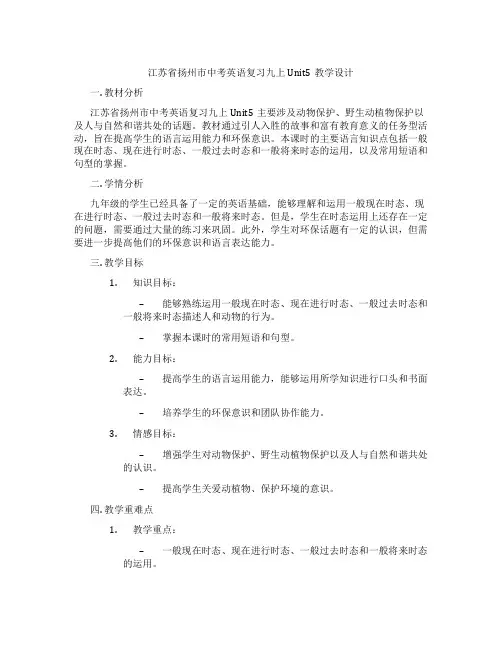
江苏省扬州市中考英语复习九上Unit5教学设计一. 教材分析江苏省扬州市中考英语复习九上Unit5主要涉及动物保护、野生动植物保护以及人与自然和谐共处的话题。
教材通过引人入胜的故事和富有教育意义的任务型活动,旨在提高学生的语言运用能力和环保意识。
本课时的主要语言知识点包括一般现在时态、现在进行时态、一般过去时态和一般将来时态的运用,以及常用短语和句型的掌握。
二. 学情分析九年级的学生已经具备了一定的英语基础,能够理解和运用一般现在时态、现在进行时态、一般过去时态和一般将来时态。
但是,学生在时态运用上还存在一定的问题,需要通过大量的练习来巩固。
此外,学生对环保话题有一定的认识,但需要进一步提高他们的环保意识和语言表达能力。
三. 教学目标1.知识目标:–能够熟练运用一般现在时态、现在进行时态、一般过去时态和一般将来时态描述人和动物的行为。
–掌握本课时的常用短语和句型。
2.能力目标:–提高学生的语言运用能力,能够运用所学知识进行口头和书面表达。
–培养学生的环保意识和团队协作能力。
3.情感目标:–增强学生对动物保护、野生动植物保护以及人与自然和谐共处的认识。
–提高学生关爱动植物、保护环境的意识。
四. 教学重难点1.教学重点:–一般现在时态、现在进行时态、一般过去时态和一般将来时态的运用。
–掌握本课时的常用短语和句型。
2.教学难点:–时态的混合运用。
–如何在实际情景中灵活运用所学知识。
五. 教学方法1.任务型教学法:通过设置各种任务,让学生在完成任务的过程中运用所学知识,提高语言运用能力。
2.情境教学法:创设真实的情境,让学生在具体的情境中感知和运用英语。
3.合作学习法:引导学生进行小组讨论和合作,培养团队协作能力。
六. 教学准备1.教学材料:教材、多媒体课件、教案、练习题等。
2.教学设备:投影仪、计算机、音响等。
七. 教学过程1.导入(5分钟)–利用图片或视频展示一些动物,引导学生谈论动物的特点和生活习性。
人教新目标英语九年级Unit5全单元教案
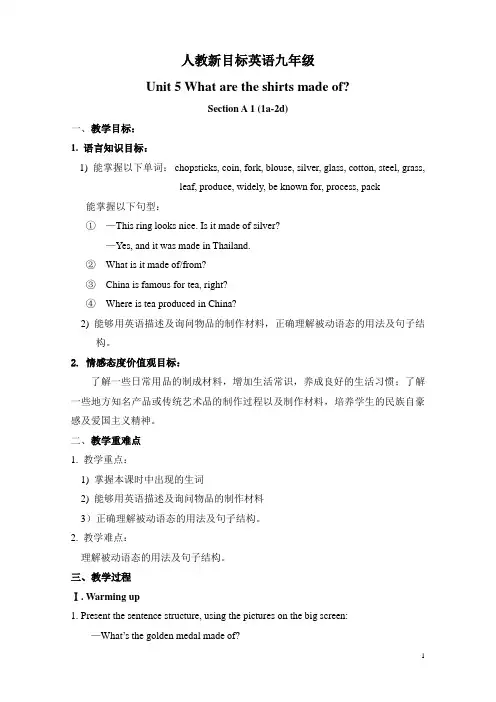
人教新目标英语九年级Unit 5 What are the shirts made of?Section A 1 (1a-2d)一、教学目标:1. 语言知识目标:1) 能掌握以下单词:chopsticks, coin, fork, blouse, silver, glass, cotton, steel, grass,leaf, produce, widely, be known for, process, pack 能掌握以下句型:①—This ring looks nice. Is it made of silver?—Yes, and it was made in Thailand.②What is it made of/from?③China is famous for tea, right?④Where is tea produced in China?2) 能够用英语描述及询问物品的制作材料,正确理解被动语态的用法及句子结构。
2. 情感态度价值观目标:了解一些日常用品的制成材料,增加生活常识,养成良好的生活习惯;了解一些地方知名产品或传统艺术品的制作过程以及制作材料,培养学生的民族自豪感及爱国主义精神。
二、教学重难点1. 教学重点:1) 掌握本课时中出现的生词2) 能够用英语描述及询问物品的制作材料3)正确理解被动语态的用法及句子结构。
2. 教学难点:理解被动语态的用法及句子结构。
三、教学过程Ⅰ. Warming up1. Present the sentence structure, using the pictures on the big screen:—What’s the golden medal made of?—It’s made of gold.—Is this table made of wood?—No, it isn’t. It’s made of glass.—Is Butter made from meat?—No. It’s made from milk.II. Presentation1. Show some pictures on the big screen. Try to learn the new words using “be made of”structure.Learn the new words: chopsticks, coin, fork, blouse, silver, glass, cotton, steel, grass, leaf2. Ss discuss with their partner and try to learn the new words.3. Give Ss five more minutes to remember the new words.4. Work on 1a:Let Ss read the things and materials in 1a. Discuss with their partners and match them with the materials. More than one answer is possible.What are these things usually made of? Match them with the materials. More than one answer is possible.Check the answers with the Ss.III. Listening1.T: Tell Ss they will hear a conversation about some things and material. Listen andmatch the products with what they are made of and where they were made.2. Let one student read the words in the box, Play the recording for the Ss to listen.3. Ss try to listen and match the things with the material and here they were made.4. Play the recording again. Let Ss answer the questions.1) How much did Susan pay for the three shirts?29 dollars.2) What does Anita feel about the three shirts?Cheap.3) What are the shirts made of?Cotton.4) Where were they made?America.5) Where did Susan buy the chopsticks?Korea.6) How does Anita like the chopsticks?Cool.7) What else does Susan show?Ring.8) Where was the ring made?Thailand.9) What will Susan do with the ring?She give it to her friend.IV. Pair work1. Read the conversation in the box in 1c.2. Ss try to made conversations using the information in 1b.e.g. A: Your new shirt looks very nice. Is it made of cotton?B: No, it isn’t. It’s made of silk.3. Let some pairs read out their conversations.V. ListeningPre-listeningfair adj. 公平的; 合理的; 美丽的fair n. an event at which people orbusinesses show and sell productsa book faira trade fairWork on 2a:T: Let’s listen to another conversation between Nick and Marcus.1. What are they talking about? First, let’s look at the pictures and the phrases in 1a.(Let one students read the phrases in 2a.)Listen and check ( √) the main topic of Nick and Marcus’ conversation.____ the science museum____ the art and science fair____ environmental protection____ a model plane____ a beautiful painting____ grass and leaves2. Play the recording for the Ss to listen and check the phrases.3. Play the recording again to check the answers.Work on 2b:1. Let Ss read the sentences below. Explain some main sentences for the Ss. Make sure they know what to do.2. Let Ss read the questions in 2b. Make sure they understand the meaning of each question.Play the recording for the Ss to answer the questions. (If necessary, using the pause button.)1) Where is the art and science fair?_________________________2) Do Nick and Marcus have to pay to go?_________________________3) What is the model plane made of?_________________________4) What is the painting made from?__________________________3. Play the recording again and mark true or false.1) The art and science fair is just inside the science museum.2) The fair is mainly about planes and paintings.3) All the works at the fair were made by university students.4) The model plane is very big.5) The painting is made of wool and grass.6) The students are asked to pay for the art and science fair.7) The students are interested in environmental protection and recycling.VI. Pair work1. Tell Ss to make a conversation using the information in 2a and 2b.e.g.A: What did you see at the art and science fair?B: I saw a model plane.A: What is it made of?B: It’s made of steel, glass, and plastic.2. Let Ss make their own conversations.3. Practice their conversations in pairs.VII. Role-play1. Work on 2dRead the conversation and complete the blanks.1) Chinese _____________ tea both in the past and now.2) _________ I know, tea plants _________ on the sides of mountains.3) When the leaves are ready, they _______ by hand and then _______ for processing.4) The tea ____________ and sent to many different countries and places around China.5) People say that tea ___________ ____ health _____ business!2. Read the conversations and Let Ss read after the teacher.3. Ask Ss to role-play the conversation in groups.VIII. Language points1. What is the model plane made of?What is the painting made from?be made of与be made from 辨析两词组都是“由……制成的”之意。
人教版九年级英语Unit5复习导学案
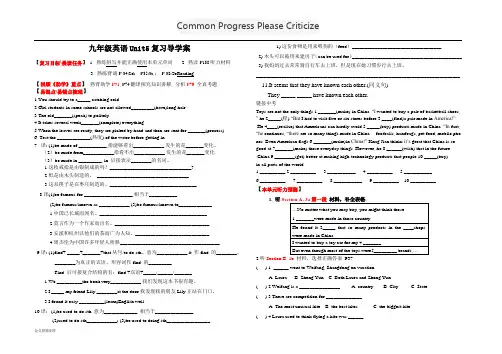
九年级英语Unit5复习导学案【复习目标\晨读任务】1. 熟练拼写并能正确使用本单元单词. 2. 熟读P138听力材料.3. 熟练背诵P 34:2d; P35:3a, ;P 38:2bReading.【回顾《助学》重点】熟背助学P71,P74翻译探究知识讲解, 分析P79全真考题.【易混点\易错点梳理】1.You should try to a_____ catching cold.2.Girl students in some schools are not allowed_________(have)long hair3.The old_______(speak) to politely.4.It takes several week_______(complete) everything.5.When the leaves are ready, they are picked by hand and then are sent for _______(process).6. Test the _____________(热度) of the water before getting in.7. 译: (1)be made of ___________,指能够看出____________.发生的是_______变化。
(2)be made from____________指看不出____________.发生的是_______变化(3)be made in _________, in 后接表示________的名词。
1.这枚戒指是由银制成的吗?________________________________?2.纸是由木头制造的。
____________________________________.3.这双筷子是在枣庄制造的。
__________________________________.8.译(1)be famous for ___________________,相当于___________(2)be famous/known as ____________.(3)be famous/known to_____________.1.中国已长城而闻名。
人教版初中英语九年级全册unit5Whataretheshirtsmadeof优秀教学案例
(三)学生小组讨论
1.布置任务:分组讨论并完成一个关于环保的短剧,要求运用本节课所学知识。
2.学生分组,每组成员分工合作,共同完成任务。
3.引导学生围绕环保主题,运用所学语言知识进行角色扮演和对话练习。
4.给予学生必要的帮助和指导,确保他们能够顺利完成任务。
(四)反思与评价
1.组织学生进行课堂反思,引导学生总结所学知识和技能。
2.鼓励学生分享自己的学习心得和体会,培养他们的自我评价能力。
3.通过学生互评和教师评价,对学生的语言运用和合作能力进行综合评价。
4.关注学生的个体差异,给予不同水平的学生个性化的关注和指导,促进他们的全面发展。
四、教学内容与过程
(二)讲授新知
1.通过PPT展示一般现在时的被动语态结构,如“The shirts are made of cotton.”。
2.讲解一般疑问句及其回答,如“What are these shirts made of?”,“They are made of cotton.”。
3.举例说明衣物材质的多样性,如棉、丝、毛、合成纤维等,并引导学生进行实际操作,练习表达。
4.设计环保主题的短剧,让学生在角色扮演中运用所学知识,提高交际能力。
(二)问题导向
1.针对衣物材质和环保话题,设计一系列问题,引导学生进行思考和讨论。
2.通过提问,激发学生对环保问题的关注,培养学生独立思考和解决问题的能力。
3.引导学生从不同角度分析问题,如生产、消费和回收等,全面了解衣物材质对环境的影响。
针对本节课的内容,我设计了一系列实用的教学活动。首先,通过展示不同材质的衣物及其生产过程,让学生了解各种材料对环境的影响,从而引出本节课的主题。接着,采用任务型教学法,让学生分组讨论并完成一个关于环保的短剧,旨在培养他们的合作意识和创新精神。在课堂总结环节,组织学生进行反思,探讨如何在日常购物中践行环保理念,将学习成果运用到实际生活中。
人教新目标英语九年级Unit5期末复习学案
unit 5复习教案Learning aims:1.Get students to go over useful words and expressions in units9-10.2. Enable the students to master the important language points by practice.3.Develop the students ability to use the important language points. Learning Important points:Enable the students to review and use the important language points . Learning Difficult points:Get the students to turn what they ha ve learned into their abilities.Learning procedures:step Ⅰ Check upHave a dictation about some useful words in unit 5.step ⅡSelf—learningRevision the following expressions1.be made of 由...制作/制造(材料)2.be made in在...制作/制造 (产地)3.be made from由......制造/制成4.environmental protection环境保护5.be famous for 以......闻名;为人知晓/ be known for以......闻名6.be produ ced in在......生产7. be used for被用于......8.as far as I know据我所知 9.pick by hand手工采摘10. turn... into把......变成...... 11.no matter不论12.all over(around) the world全世界 13.even though即使14.avoid doing sth避免做某事15.everyday things日常用品16.find out 查明;弄清 17.go o n a vacation去度假18.paper cutting剪纸 19.such as 例如20. send for发送;派人去请21.send out发出;放出;发送22.be covered with被......覆盖 23.rise into上升到;升入24.put on 张贴 25.a s symbols of作为......的象征26.fairy tale 童话故事stepⅢExplanation and summary1.Get the students to master the following language points.1.被动语态:Be+及物动词的过去分词2.No matter +从句“无论”3.Find it +形容词+that 从句“发现···是怎样的”4.It seems that +从句“好像···”5.Buy sb. sth. =buy sth for sb 给某人买某物6.Avoid doing sth 避免做某事7.Allow sb to do sth 允许某人做某事8.Want to do sth 想做某事9.Learn to do sth 学会做某事10.Try to do sth 尽力做某事11.It takes +一段时间+ to do sth 做某事花费多长时候ed to do sth 过去常常做某事StepⅣSelf—checkGet the students to do some related exercise in their exercise book. step ⅤHomework1.Finish the rest exercises in this period.2.Summarize what they have learnt in this period and make notes. Blackboard Design。
九年级英语全册 Unit 5 (第2课时)教案
Unit 5 What are the shirts made of?(第2课时)一、教材分析:本节课的主要话题是谈论产品由什么制造及其产地,同时在文中巩固复习被动语态的构成及应用。
二、三维目标(一) 知识与技能1. To learn more about passive voice.2. To understand the pasage on Page35.(二) 过程和方法3. To get a general knowledge of the passage by reading and role-play.4. To know how to make sentences and express correctly using passive voice.(三) 情感态度和价值观5. After learning this part, every student will know more about products and learnto be cooperative in the course of learning.三、教学重点1. Further learning about passive voice.2. to understand the passage on Page 35.四、教学难点1. To know the sentence pattern: find it + 宾补 + that …2. to understand the passage on Page 35.五、教学策略根据本课教学目标和重点内容,教师可采用听,读,小组讨论,角色扮演等活动来引导学生进行学习。
六、教学准备ppt, recorder, mutiple-media七、教学环节1、课堂导入Step 1 Lead-inRole—play\Role—play the conversation on Page 34Pam: China is famous for tea, right?Liu Jun: Yes, both in the past and now.Pam: Where is tea produced in China?Liu Jun: Well, in amny different areas. For example, Anxi and Hangzhou are widely known for their tea.2. 课堂讲授Step 2. Reading1) Fast-readingNow turn to page 35 and read the page quickly to find answers to the questions.1.Where did Kang Jian go to visit his uncle and aunt?2.What did he discover in the toy stores?3.Why did he have to visit many stores before buying a pair ofbasketball shoes?4.What did he realize after his shopping experiences?Answers:1. He went to San Francisco.2. Most of the toys had American brands, but they were made in China.3. He want to find a pair of shoes made in America.4. He realized that Americans can hardly avoid buying products made in China.2) careful-readingRaed the passage again and write what the underlined word refer to.1. No matter what yoy may buy, you might properly think those products were madein those countries.those:_______________________those: ______________________2. He found it interesting that so many products in local shops were made of China. it: ____________________________3. I want to buy a toy car for my cousin, but even though most of the toys hadAmerican brands, they were made in China.they:_______________________Answers: 1. the products he saw in other countriesJapan, France, Switzerland…2. so many products in local shops were made of China3. most of the toys he saw in America3) Studying useful structures.1) He found it interesting that so many products in local shops were made of China.本句结构为:Find + it + 宾补+ that / to do…It在句中为形式宾语。
人教新目标英语九年级Unit5 复习学案(含答案)
秋季初三英语讲义一、本堂内容【知识点一】根据汉语和首字母提示完成单词。
1. She was wearing a blue __________________(衬衣).2. Is it made of _________________(棉花), silk or wool?3. Jim is going to collect _____________________(材料)for a new book.4. Both New York and London have __________________(交通)problems.5. The water _______________________(表面)is like a mirror.6. They built a wall to _________________(避免)soil being washed away.7. I am pleased with your _____________________(产品).8. The internet has become part of _________________(每天的)life.9. The __________________(邮递员)brought me a large package.10. Our Chinese always use ______________________(筷子)to eat, but the English don't use them.11. There is a pair of _________________________(剪刀)in the bottom drawer.12. That is a great __________________(国际的)question of the day.13. Children enjoy listening to __________________(童话)tales.14. As soon as I ___________________(完成)my training, I am going to be a doctor.15. He told us a very ___________________(生动的)story about his life in Africa.16. Children always like ___________________(气球).17. We are going to _____________________(法国)to spend our holidays.【知识点二】重点短语1.be made of________________2.be made from_______________3.environmental protection_________4.be made in____________5.以......闻名;为人知晓 ___________6.be produced in_____________7.作为….著名_____________ 8.据我所知 _________________9.pick by hand_____________ 10..全世界________________11.不论;无论______________ 12.即使_________________13.避免做某事 _______________ 14.everyday things_________15.according to ________ 16.paper cutting___________17.such as ____________ 18.把......变成...... ________19.send out____________ 20.被......覆盖 ___________21.be seen as ____________ 22.as symbols of___________23.fairy tale _______ 24. in trouble _______【知识点三】重点句1. China is famous for tea, right?be famous for=be known for… 意为;___________。
- 1、下载文档前请自行甄别文档内容的完整性,平台不提供额外的编辑、内容补充、找答案等附加服务。
- 2、"仅部分预览"的文档,不可在线预览部分如存在完整性等问题,可反馈申请退款(可完整预览的文档不适用该条件!)。
- 3、如文档侵犯您的权益,请联系客服反馈,我们会尽快为您处理(人工客服工作时间:9:00-18:30)。
九年级英语上Unit 5复习It must belong to Carla学习目标:表示对当前发生的事情做出推测和判断学会做出推测和判断。
一、词汇author作家toy玩具picnic野餐symphony交响乐optometrist验光师appointment约会,约定algebra数学,代数学crucial关键的,致关重要的count计,算chase追逐,追赶garbage垃圾pretend装作二、词组1. belong to 属于2. hair band 发带3. because of 因为4. Chinese-English Dictionary汉英词典5. Oxford University牛津大学6. use up 用光、用完7. the only kid独生子,唯一的孩子8. classical music古典音乐9. make guesses做出猜测10. outside our window在窗子外面11. no more 不再12. escape from逃离13. be careful of留神、当心三、日常用语1. Whose volleyball is this?It must be Carla’s. She loves volleyball.2. Whose French book is this?It could be Ali’s. She studies French.3. Whose guitar is this?It might belong to Alice. She plays the guitar.4. Whose T-shirt is this?It can’t be John’s. It’s much too small for him.四、知识讲解Section A:1. If you have any idea where it might be, please call me.If you have any idea... = If you know... 意为“如果你知道……”。
any用于if引导的条件从句中,有“若干的,有多少”的意思。
例如:If you have any time I’d like to talk with you.如果你有(些许)时间,我希望与你谈谈。
2. no more 与not …any more的区别二者都表示“不再”,“再没有”的含义但no more要用在谈数量或程度时,no more用在说时间时。
例如:There is no more bread.没有面包了。
(指数量)He’s no more genius than I am.他和我都不是天才。
(指程度)He doesn’t live here any more.他不住在这里了。
(指时间)3. I think I dropped it during the concert so it might still be in the symphony hall.during是介词,意为“在……期间”,其后跟时间段。
在引导时间状语时注意区分和for的用法。
介词for引导时间状语时,很易和during混淆不清。
它们的区别如下:(1)during用在已知的时期、节日或表示时间观念的名词之前。
其后通常接the、this、that、these、those、my、your、his……等词。
例如:during the last four daysduring the winterduring that timeduring my holidaysduring our stay in Japan而for则用以表示“有限的”或“无限的”时间概念,通常其后接冠词、数词,复数名词或副词ever。
例如:for the first timefor two monthsfor many yearsfor yearsfor ever(2)during的涵义是“当……之际”。
它既可指某个动作在某个时期里连续不断地进行,也可以指某个动作在这段时期里的某个时间发生。
例如:It snowed all day but stopped snowing during that night.下了一整天雪,到晚上才停了。
而for的涵义是指某个动作在某个时期里处于连续不断的状态。
例如:They worked for the whole day.他们干了一整天。
在某些场合下,for含有“预先安排”或“为了某一目的”之涵义。
表示此意味时,大都和come、go、stay、lend、rent、hire等词连用。
例如:They will stay with us for the New Year.他们将和我们在一起,共度新年。
Section B:(一)However, these days, strange things are happening in our neighbourhood and everyone is unhappy.然而,最近在我们附近却在发生一些奇怪的事情,并且每个人都不高兴。
1. however是一个转折连词,表示“然而,可是”的意思,与but的意义相同,但however是较正式的说法。
例如:I know how to pronounce this English word, however I can’t write it.我知道怎么读这个英语单词,但是我不知道怎么写。
2. these days意为“最近,近来,近几天。
”3. unhappy是happy的反义词。
unhappy是一个合成词,由un+happy组合而成。
我们常用的在词前加前缀变为其反义词的有:(二)My parents called the police, but they can’t find anything strange.我的父母亲报了警,但他们也没能发现奇怪的东西。
(1)the police可以看作为复数名词,意思是“警察、警方”。
但如果指一个警员,就要用a policeman或a policewoman。
(2)can’t在本句中,不表示“推断”,而表示“能力”。
(三)In my dream, I was swimming in an ocean of paper.在我的梦中,我浸泡在数不尽的试卷中。
(in)an ocean of, 或(in)oceans of是介词短语,口语中常用,意为“极多的,用不尽的”。
在of后接不可数名词或可数名词复数形式均可。
例如:He thinks he has oceans of time.他认为他有用不尽的时间。
语法:表示推测的情态动词。
在英语中,表示对某件事物的确定程度,即表示推测的时候,我们通常会用到以下情态动词,must, might, could, may, can’t, couldn’t.一. can和could的区别和用法1.can表示体力和脑力方面的能力,或根据客观条件能做某种动作的”能力”。
例如:Can you speak English?What can I do for you?Can you make a cake?can用在否定句和疑问句中时有时表示说话人的“猜测”或“不肯定”。
例如:Where can he be?Can the news be true?(在日常会话中,can可代替may表示”允许”,may比较正式)2. could 是 can的过去式,表示过去有过的能力和可能性,还有怀疑和不肯定的意思(在否定和疑问句中)。
例如:The doctor said he could help him.(能力)She couldn't skate when she was five years old. (能力)At that time we thought the story could be true.(可能性)could用来提问,是有礼貌的请求 Could.... Please? 语气较为婉转。
例如:Could I speak to Mr. Smith, please?Could you help us carry this box, please?二. 跟上组词一样, might也是may的过去式,其用法如下:1. may的用法:a. 表示”允许”或”请求”。
例如:May I come in?在使用这一用法时需注意: may表示”允许”的否定形式是must not,意思是”不应该”“不许可”。
例如:—May I take this book out of the reading-room?—No,you mustn't.不行。
b. 表示说话人的猜测,认为某一事情”或许”或”可能”发生。
例如:He may know the answer.Tomorrow I may go shopping.c. may用在感叹句中可表示祝愿、愿望。
例如:May you succeed.(祝你成功。
)May you have a pleasant journey.(一路平安。
)2. might的用法:a. might可以代替may,表示现在时间的动作,但语气较为婉转客气或更加不肯定。
例如:He might not come today.Might I take a suggestion?b. might用来表示现在时间时,还可表示”规劝”。
例如:You might pay more attention to spoken English.三. must与have to的区别have to比较强调客观需要,must着重说明主观看法。
另外have to能用于更多时态,比较下面的句子:We had to be there at ten.我们得在十点钟到那里。
We'll have to reconsider the whole thing.这一切我将不得不重新加以考虑。
有时两者都可以用,意思差别不大。
例如:We must have to leave now.我们得走了。
must在表示说话人对事物的推测时候要注意它比may肯定得多,相当于汉语的”一定”或”准是”。
(只有在肯定句中能这样用。
)This must be your room.There must be a mistake.在回答由must引起的问题时,如果是否定的答复,不能用mustn't,而需要用needn't或don't have to,因为mustn't是”一定不要”的意思。
例如:—Must we hand in our exercises today?—No,you needn't.must not的否定形式则表示”不应该”或”不许可”,语气比较强烈。
